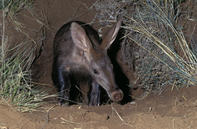Ants and Termites

Aardvarks feed mainly on ants in the dry season, while termites are mostly inactive, and feed on termites during the wet season when termites are especially active. They will forage in a seemingly random manner zigzagging across the veld and smelling out columns of termites moving above the ground or ant nests below it.
They utilize the same mounds repeatedly opening up old excavation wounds and marking favoured feeding sites with a secretion from glands in the groin. Although the excavations of aardvarks do open up termite mounds to invasions by Matabele ants, the termites biggest predator, the aardvarks themselves do not eradicate whole termite populations when they feed.
They favour the eggs and larvae of their prey and worker termites are preferred to soldiers as they have higher calories and fewer toxins but to get at these he must dig past the soldier’s defences, which don’t seem to faze them in the least. Ants may cover an aardvark’s face completely and it will only show the faintest irritation by shaking its head once in a while.
Burrow Uses
Aardvarks are exceptional diggers and are able to dig into the cement-like substrate of the hardest termite mounds. In sandy soil, aardvarks can dig themselves out of trouble digging faster than men with spades.
They push the dirt backwards with their feet and sweep it away with the muscular tail. Aardvarks do not only dig for food or to escape predators but they also excavate burrows in which to live. These burrows begin with a tunnel just wide enough to accommodate the aardvark’s body so that larger predators can’t pursue them down their holes. They can’t be dug out of their holes as they generally dig faster than their pursuers.
The tunnel may be up to 10 m long depending on the substrate and opens into a wider chamber, which serves as the aardvark’s sleeping and breeding quarters as the microclimate here is stable. The earth excavated out of the ground is left in a heap at the entrance and sometimes soil remains on the floor of the tunnel.
This is pushed back and forth when the aardvark enters or leaves the burrow and is used to seal the aardvark into the safety of its burrow and close intruders out. The disused burrows of aardvarks are utilized as homes by no less than 17 mammal species, two reptiles and a couple of birds.
These include bats, cats, civets, hyenas, jackals, porcupines, warthogs, wild dogs, monitor lizards, owls and kingfishers. The feeding excavations of aardvarks greatly benefit the aardwolf, which doesn’t have the same digging capabilities and will feed in the wake of the aardvark.
By Megan Emmett